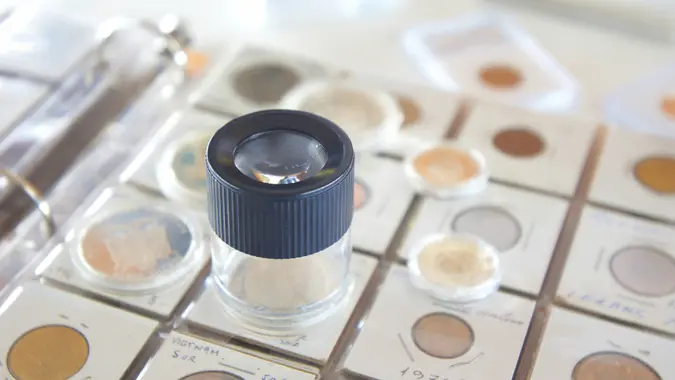33% of US Millionaires Are Women: 5 Hurdles Keeping Women From Becoming Millionaires

Commitment to Our Readers
GOBankingRates' editorial team is committed to bringing you unbiased reviews and information. We use data-driven methodologies to evaluate financial products and services - our reviews and ratings are not influenced by advertisers. You can read more about our editorial guidelines and our products and services review methodology.

20 Years
Helping You Live Richer

Reviewed
by Experts

Trusted by
Millions of Readers
There are over 7 million women millionaires in the U.S., a number that represents one-third of all millionaires in the country. While that number is growing, women still face significant obstacles to meeting this important financial milestone.
Let’s look at five barriers and what you can do about them on your path to seven figures.
Also, see four things women can start doing today to grow their wealth.
The Pay Gap is a Lifelong Obstacle
Women make 83 cents for every $1 paid to men. Not only that, according to research by PayScale, “women reach their peak earnings at the age of 44, earning on average $66,700. Men reach their peak earnings at the age of 55, earning on average $101,200.”
The difference in wages adds up over time. A study commissioned by Merrill Lynch and Age Wave shows that the cumulative lifetime earnings gap between men and women is $1,055,000 at retirement age. Not only that, but lost wages and years also mean lost opportunities for wealth-building tools, including lower employer benefit contributions (HSA, 401(k), etc.) and lower pre-tax savings opportunities.
What’s more, women lag in overall measures of wealth — with the average single woman having only a quarter of the wealth of an average single man.
Overcoming this hurdle: Start early to beat gender pay gaps and wealth gaps. Negotiating your entry-level salary will be a lot easier than evening out the score when your executive salary falls short of your male colleagues. That said, it’s never too late to negotiate for more.
Caretaking Falls to Women
A study by Merrill Lynch and Age Wave found that “women spend 48% of their adult lives outside of the workforce versus only 28% for men, including time spent in retirement and caring for children, aging parents and spouses.” This statistic is even more shocking when you realize that most financial models and retirement planning calculators are created for men’s salaries, spending and career paths. In short, women must make their first million in less time than men.
Overcoming this hurdle: Leaving the workforce to have children or take care of aging relatives is a huge part of many women’s lives. To minimize potential downsides, consider a side hustle or freelance work if that fits into the picture. Or even take classes to fill skill gaps in your resume. When you’re ready to go back, you can jump into a comparable (or even better!) role and salary.
Building Wealth Takes Time
We all know that the best time to start saving is at the beginning of our career. And the second-best time is today. Maybe you haven’t had a traditional career path with employer contributions to retirement. Or maybe you’ve had trouble budgeting or an unexpected life event knocked back your savings plan. It’s okay. You can start today and start small.
Women may be uniquely suited to hang on for the long haul, especially when it comes to investments.
Regina Moore, cofounder of Women’s Personal Finance, says that “women tend to buy and hold at a higher rate than men. This strategy has time and time again shown better long-term returns (in broad investments).” Moore sees less hubris in women investors. “We’re wise enough to know we’re unlikely to beat the market — and emotionally intelligent enough to ride the waves with our long-term goals in mind.”
Overcoming this hurdle: Women do tend to be more cautious investors (we’ll tackle taking risks in a moment), so lean into this quality and hold on for the long haul. Remember, putting even a little bit more away this week than you did last week is a step in the right direction.
Women Face Barriers to Entrepreneurship
Women entrepreneurs face steep challenges, among them a cultural expectation to avoid risk at all costs. But starting a new venture is inherently risky, and if you’re not taking chances, you’re probably not putting yourself on a path to success. Remember, the beginning is the time to take your biggest swings — you have less to lose and far more to gain.
Overcoming this hurdle: If you’re aiming to make your first million doing what you love, remember to keep learning every day, gather mentors and dive into the biggest risks right at the start.
Women Think They Don’t Know Enough
Women want to know more about personal finance and investing, and they want experts who understand their unique needs and perspectives. Luckily, financial services firms are getting smart about products and services geared towards women, so we don’t have to settle for someone who doesn’t get what we want or talks down to us.
What’s more, the world needs more women investors. One UBS report cited a finding from BNY that women could add more than $3.22 trillion of additional capital to global investments if they participated at the same rate as men. What’s more, gender equity would result in “over $1.87 trillion flowing into more responsible investing.”
Overcoming this hurdle: Get educated about investing. Embrace a growth mindset, the belief that you can get better at anything with effort. You don’t have to learn everything all at once. Watch a YouTube series or make an appointment with a certified financial planner to discuss your options.
Young Women Are Leading the Way
A study by Barbara Stewart on women and finance found that among 18-to-29-year-old US women, 64% either already invest or plan to start within the year, higher than any other age group. By investing at a young age, these women are putting themselves on a path to their first million and hopefully closing the millionaire gender gap in the process.
 Written by
Written by  Edited by
Edited by 

























